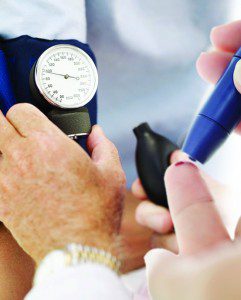By Suhail A. Khoury, M.D., F.A.C.P., Ph.D.
 Diabetes mellitus (DM) is a multi-system disease characterized by chronic elevation of blood glucose. The etiology of DM is either related to lack of insulin production (Type 1, or juvenile DM 1) or to the lack of response to insulin (Type 2, or adult onset DM 2). This summary is limited to DM 2.
Diabetes mellitus (DM) is a multi-system disease characterized by chronic elevation of blood glucose. The etiology of DM is either related to lack of insulin production (Type 1, or juvenile DM 1) or to the lack of response to insulin (Type 2, or adult onset DM 2). This summary is limited to DM 2.
DM 2 affects more than 90 % of all cases of diabetes. This represents about 4% of the adult population. It is associated with obesity, older age, and sedentary lifestyle and tends to be inherited. DM 2 is related to insulin resistance, either due to a decreased number of insulin receptors or developing dysfunctional receptors. It is also affected by hormones from the intestines called Incretin hormones. These are usually secreted during meals and contribute to most of insulin secretion after eating (known as post prandial). They also suppress glucagon secretion. Glucagon stimulates glucose production. Incretin release is significantly reduced in patients with DM 2. Type 2 diabetics initially produce more insulin than non- diabetics, in an attempt to compensate for the insulin resistance. This eventually leads to destruction of the insulin producing cells in the pancreas (Beta cells) and will subsequently require insulin injections. DM may also develop due to medications (like cortisone and thiazide diuretics), other illnesses (involving the pituitary and adrenal glands) or due to pregnancy (known as gestational diabetes).
Patients with DM often present with complaints of unintentional weight loss, thirst, increased urination, vaginal yeast infections, blurry vision, burning feet, decreased sensation in feet or hands, fatigue, chest pain, increased sweating, strokes and others. They also may not be symptomatic. Most DM 2 patients also suffer from central obesity with an increased “Gut to Butt ratio”.
Diabetes mellitus is associated with a remarkable increase in mortality and morbidity; causing 73,000 deaths in the US 2010. Many additional deaths were related to illnesses that resulted from diabetic morbidities. DM increases morbidity due to its effect on the endothelium, the cells that line blood vessels. Complications of DM 2 include diabetic retinopathy (most common cause of blindness), diabetic nephropathy (second most common cause of kidney failure), peripheral neuropathy, gastroparesis, peripheral arterial disease and poor healing (common cause of foot amputation), coronary artery disease (heart attacks), and vascular disease (strokes) etc.
Diagnosis of DM is easily archived with blood glucose measurement. Normal fasting blood glucose ranges from 60 to 100 mg/DL. Hemoglobin A1c measures the concentration of glucose attached to red blood corpuscles and represents the glucose concentration in the blood stream over 105 days. That is why we check it every 3 months. Glucose tolerance testing is useful in predicting gestational diabetes and in monitoring post prandial response.
Treating DM is a shared effort of patients, physicians and paramedical team. Patients must control and modify behavior to control diet, weight and exercise. If needed, employing the expertise of a nutritionist to modify not just the quantity but also the quality of food. Consulting exercise trainers to improve balance, strength and endurance is recommended. Exercise should include stretching, aerobic and resistive exercises. Dilated eye exams should be on at least an annual basis. Kidney function evaluation with blood and urine tests to be done every 6 to 12 months. Feet should be inspected daily by the patient or family. Routine foot exams should be done by a physician or podiatrist at least once a year. Diabetics should not walk barefoot and should not wear shoes without socks due to the increased risk of foot injury.
Pharmacotherapy is rapidly evolving and more agents are becoming available. These agents may increase insulin production and secretion (like Glimipride), inhibit glucose producing genes (like Metformin), increase the sensitivity of receptors to insulin (like Pioglitazone), post prandial suppression of glucagon secretion (like liraglutide), prolong the availability of incretins (like Linagliptin) and most recently agents that reduce reabsorptiotn of glucose in the kidneys(canaglifozin). Insulins, either long lasting or short acting, are also available. In general, short acting is used to decrease glucose concentration rapidly and the effect only lasts about 2 to 4 hours. The long acting agents are administered only once daily, occasionally twice, and they are used for maintenance.
Therapy is individualized; it is not one size fits all. Choice of medication is determined by the treating physicians. Nothing works if all members of the team are not committed.
Khoury Medical Institute
(941) 359-3337
5805 Whitfield Ave. . Palm-Aire Plaza . Sarasota








